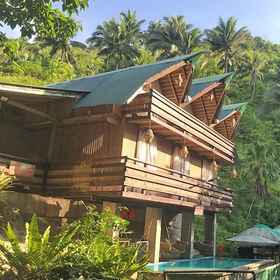
Nueva Ecija Hotels
- Hotel/
- Philippines(8505 Hotels)/
- Nueva Ecija(27 Hotels)
Destinations to Discover

Why Pay More
When You Can Pay Less?

Popular Hotels in Nueva Ecija
Discover what you like
Stay near exciting spots
Plenty of options, whatever your occasion
More about Nueva Ecija
Most travelers can be forgiven if they skip the chance to stay in Nueva Ecija and just pass through the province. After all, this province is known for being “The Rice Granary of the Philippines,” which means you’ll be passing by rice fields after rice fields. However, the province actually has a good number of interesting sites—both natural and cultural—spread across the province for those who choose to stop over.

Nueva Ecija is a landlocked province located in the Central Luzon region. It is one of the top producers of agricultural products in the country, with its farms churning out rice, corn, onions, garlic, calamansi, milk, and more. As such, it has earned the monikers “The Rice Granary of the Philippines” and the “Milk Capital of the Philippines.” While best known for agriculture, the province also has several historical sites and natural wonders that can be explored by travelers looking for a trip off the beaten path.
How to Go
By land transportation
If you’re coming from Manila, taking a provincial bus to Nueva Ecija is the best option. Most bus trips originate from terminals in Caloocan, Pasay and Cubao. It's recommended to take the Victory Liner and Five Star bus lines, especially those that pass through the Subic-Clark-Tarlac Expressway (SCTEX) for a shorter travel time of around four hours.
Getting Around
Tricycles are the main mode of transportation when commuting within cities and municipalities in Nueva Ecija. Jeepneys are also available for longer commutes, though these are mostly for traveling to city centers.
Tourist Attractions
With its rich history, Nueva Ecija has a good number of heritage sites that travelers can visit. One such example is the old convent of the St. Nicholas of Tolentine Cathedral Parish in Cabanatuan City. This was the site where General Antonio Luna was assassinated. Also in Cabanatuan City is the Camp Pangatian memorial, commemorating the so-called “Great Raid” during World War II.

Another must-visit heritage site is the Three Kings Parish Church in Gapan City, which is the oldest and biggest Spanish colonial church in the province. This church houses the Virgen La Divina Pastora, the object of Marian pilgrimages in Central Luzon. Gapan City also has several ancestral homes that feature Spanish-era colonial architecture. Some of them belong to famous Philippine celebrities, such as Nida Blanca and Eula Valdez.
Last but not the least is the Balete Pass Tourism Complex at Dalton Pass, the road connecting Nueva Ecija to Nueva Vizcaya. The complex, located at the summit, is where a World War II memorial can be found. It commemorates the various battles fought in the area, which claimed the lives of thousands of troops.
Top Things to Do

Nueva Ecija's most prominent features include hiking trails and nature parks for trekkers to visit. Some of these can be found in Minalungao National Park. The reserve has several picnic spots, river raft rides, hiking trails along its limestone walls, and caves open to public exploration. More adventurous tourists can even try out the zipline if they're looking for a thrilling activity.
Another natural wonder to visit is Gabaldon Falls, which is two hours away from Cabanatuan City. The waterfall is part of the eco-park located in the Nueva Ecija University of Science and Technology, which is accessible through a paid tour. The park has a hiking trail where you can enjoy the natural scenery of the place including rapids, rivers and natural landscapes which are perfect for breathtaking shots.
And since Nueva Ecija’s main industry is still agriculture, travelers should try the farm tours in the area. The Central Luzon State University offers a farming technology tour, while you can also book a visit to the Gross Ostrich Farm in San Leonardo. Meanwhile, parts of the Philippine Rice Research Institute (PhilRice) and the Philippine Carabao Center are both open to the public.
Where to Eat
Nueva Ecija's Cabanatuan City is a hotspot for diners looking for great eats. One such place is Rosenda’s Restaurant. It features traditional Filipino fare such as Sweet and Sour Fish Fillet, Sizzling Pork Sisig, a Seafood Casserole and its signature Rosenda’s Seafood Pancit Canton bilao. This particular noodle dish has sliced vegetables, mushrooms, and pieces of shrimps and squid—all topped with a thick sauce in the mix.

If you're looking for some sweets and drinks, then NYOrK is the place you want to visit. With the name being an acronym for Not Your Ordinary Koffee, the cafe serves a menu of ice-blended drinks, salads and savory dishes. These include Barbecue Pork Ribs, Cheesy Baked Penne and Buffalo Wings.
Finally, there is also the Rustica restaurant which features a pricier tier of delicious local eats. These include the Kare-Kareng Seafood, the Lechon Kawali and Cabanatuan Ensalada. It's recommended to order lots of rice when eating the main dishes for a real Filipino dining experience.
Nightlife
The nightlife in Nueva Ecija is limited to mostly late night bars and bistros. One recommended place is the Bistro 360 bar with its selection of local beers, sodas, and hard drinks. It also serves up a modern take on traditional Filipino dishes, with some Asian and Western fusion cuisine in the mix. Tourists can try snacks such as the Indonesian satay, crispy pork belly dinuguan and Beef Back Ribs. They also have some exotic panizza flavors like the kesong puti and longganiza.
Where to Stay
Most of Nueva Ecija's best hotels and restaurants can be found in Cabanatuan City. Those looking for mid-ranged accommodation can try Microtel by Wyndham. It features amenities such as air-conditioned rooms with chiropractor-approved mattresses, internet access, and an IDD/NDD-capable phone.

Another recommended place to stay is The Harvest Hotel . It's perfect for both business trips and family vacations as it offers over 83 rooms, a coffee bar, meeting rooms, a kids' pool, and free Wi-Fi.
Travel Tips
Facts about hotel in Nueva Ecija
Total Accommodation | 27 Properties |
Popular City | Santa Rosa, Jaen |
Popular Hotel | Harvest Hotel, Villa Esmeralda Bryan's Resort Hotel and Restaurant |
Popular Landmark | Freedom Park, Plaza Lucero |
Frequently asked questions

Guest reviews in hotel near Nueva Ecija
Why book Accommodation in Traveloka?



We’ve got more than just hotels







































 Facebook
Facebook Instagram
Instagram TikTok
TikTok Youtube
Youtube